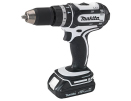
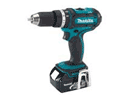 For many crafters and tool users replacing worn or damaged power tool parts has become as familiar as driving a screw. For many of those same crafters, though, the thought of replacing the armature in a power drill is daunting if not altogether discouraging. Fortunately though, replacing the armature in a cordless Makita drill, one of the most popular drill types on the market today, is a far simpler process than you might have thought. In fact, with just a dash of courage and a handful of generally simple steps, you can remove and replace the armature in your Makita cordless drill like a true cordless-drill-armature-replacing fool.
For many crafters and tool users replacing worn or damaged power tool parts has become as familiar as driving a screw. For many of those same crafters, though, the thought of replacing the armature in a power drill is daunting if not altogether discouraging. Fortunately though, replacing the armature in a cordless Makita drill, one of the most popular drill types on the market today, is a far simpler process than you might have thought. In fact, with just a dash of courage and a handful of generally simple steps, you can remove and replace the armature in your Makita cordless drill like a true cordless-drill-armature-replacing fool.
First, as with any other cordless tool repair procedure, you must turn-off the drill and remove its battery. Next, you simply need to crack into the tool.
Lay the tool down on a sturdy flat surface and remove the drill’s end-cap (pictured below and to the right) and the top half of its clamshell or housing. The end-cap is the dome-shaped section of the housing directly opposite the chuck. Both the housing and end-cap will be held together with star-head screws, accordingly, you will require a star-head screw driver or drill bit to properly open the housing. Set the screws and the top half of the housing safely aside as you continue.
half of its clamshell or housing. The end-cap is the dome-shaped section of the housing directly opposite the chuck. Both the housing and end-cap will be held together with star-head screws, accordingly, you will require a star-head screw driver or drill bit to properly open the housing. Set the screws and the top half of the housing safely aside as you continue.
Now that all your power tool’s guts and glory are exposed, you will need to remove a few pieces before gaining full access to the armature. First, release the heat sink. This is an L-shaped piece of metal attached to the switch by a series of wires that latches-down over the armature and yoke. Simply pull and place it out of the way. Next, carefully remove the tool’s gear-box and brush-holder.
Take note of how these pieces are placed and positioned so that when reinstalling them, every component comes back together properly.
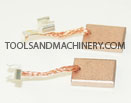 At this point, and because you’ve already got the tool cracked open, it is also a good idea to check the integrity of your brushes. These little suckers are certainly no strangers to wear and tear and it is never a bad idea to replace them where there are indications of damage. So, if your brushes look worn or crumbly, replace them before completing your repair.
At this point, and because you’ve already got the tool cracked open, it is also a good idea to check the integrity of your brushes. These little suckers are certainly no strangers to wear and tear and it is never a bad idea to replace them where there are indications of damage. So, if your brushes look worn or crumbly, replace them before completing your repair.
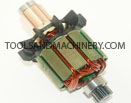
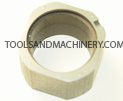 Now that you have gained access to the armature, simply remove the armature and yoke, which at this point, will be connected and removed as one piece. The yoke is an open ended casing which fits over the fattest part of the armature’s body. Simply pull the two apart and insert the new armature into the yoke in the same fashion the damaged armature was removed.
Now that you have gained access to the armature, simply remove the armature and yoke, which at this point, will be connected and removed as one piece. The yoke is an open ended casing which fits over the fattest part of the armature’s body. Simply pull the two apart and insert the new armature into the yoke in the same fashion the damaged armature was removed.
Next, you will simply need to move backwards through procedure. This time, however, you get to combine a few steps. In fact, you will essentially insert all components thus far removed as one singular piece. In other words, insert the yoke and armature, the gear-box, and brush-holder simultaneously.
To do this, use the armature to push the brushes into the brush-holder. Ensuring the brushes can make complete contact with the armature, simply squeeze the two together and, holding that position, square the gear-box to the armature’s other side. Slide the components into the housing together ensuring they are positioned identically to their pre-removal stations. While inserting, you must also match the notch in the yoke to the plastic notch-catch that is molded into the drill housing. Matching and securing these points will ensure the armature (and surrounding components) remains in the right place inside your drill. NOTE: to match these points, the notch in the yoke will face directly away from you, or, what is now the very bottom of the drill.
Now that the armature and yoke, the gear-box and brush-holder are secured properly in place, replace the heat-sink. Next, replace the top-half of the drill housing and the end-cap. Here, be especially careful not to damage the threads of your star-head screws. This ensures that no matter how many times you need to break into your drill, those screws remain tight.
Lastly, to ensure everything has come back together properly, you simply need to test the drill. Attach the battery, engage the tool, and drill a few screws. If everything runs smoothly, then, congratulations, you have successfully replaced the armature in your Makita cordless drill. If everything doesn’t run smoothly, remove the housing once more and retrace your steps ensuring each component is properly communicating with its fellows. If you can find an error, for instance, if your brushes are not making complete contact, fix it. If you can not find an error or cannot otherwise convince the tool to perform properly, take the drill to an authorized Makita service center for professional inspection.













